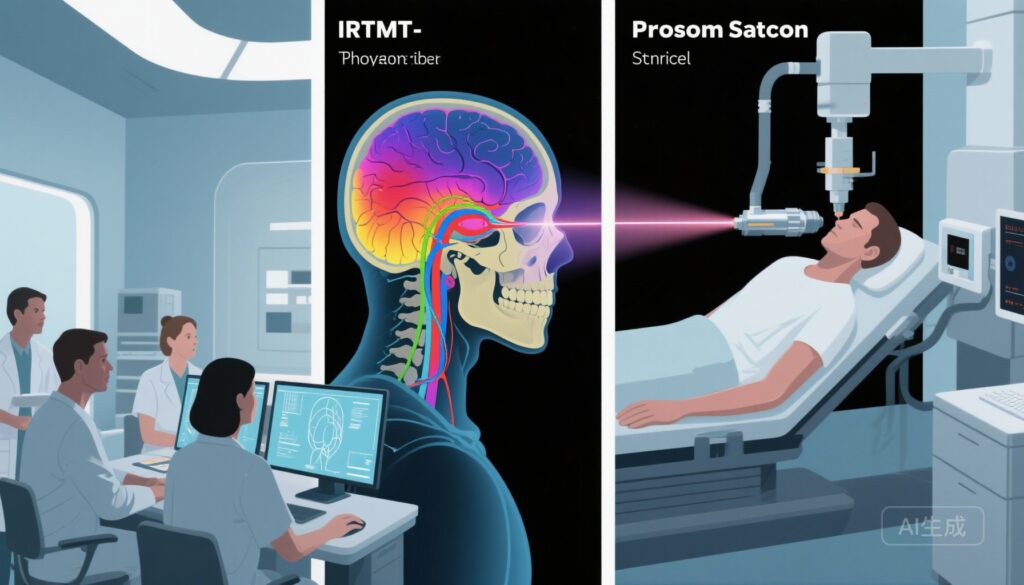Highlights
– In a 1:2 propensity-matched, multicenter cohort of 54 patients with olfactory neuroblastoma (ONB), no definitive difference was demonstrated between adjuvant IMRT and proton beam radiotherapy (PBRT) for long-term local control, recurrence-free survival, or overall survival.
– Radiation treatment–related adverse events (grade ≥2) were numerically low (20% overall) and similar between IMRT (21%) and PBRT (18%).
– Wide confidence intervals around 10-year outcome estimates indicate substantial imprecision; the study is hypothesis-generating and underscores the need for prospectively powered comparative studies.
Background
Olfactory neuroblastoma (ONB; also called esthesioneuroblastoma) is a rare malignant tumor arising from the olfactory epithelium in the superior nasal cavity and anterior skull base. Because of its anatomically challenging location near critical organs (orbits, optic nerves, brain, pituitary), management typically includes surgical resection followed by adjuvant radiotherapy for most patients, particularly those with advanced stage or higher histologic grade. Intensity-modulated radiotherapy (IMRT) using photons has become the standard adjuvant modality due to improved target conformality versus older 2D/3D techniques and its ability to spare adjacent structures. Proton beam radiotherapy (PBRT) offers a distinct physical dose distribution (Bragg peak) that can, in theory, reduce dose to uninvolved organs at risk (OARs) such as the contralateral orbit, optic apparatus, and uninvolved brain tissue. Whether this translates to improved disease control or fewer clinically meaningful toxicities compared with modern IMRT is not established for ONB, where data are limited by the rarity of the disease.
Study Design
The referenced study (Tang et al., JAMA Otolaryngol Head Neck Surg. 2025) is a retrospective, propensity score–matched cohort drawn from nine academic tertiary centers in North America. The cohort included patients with ONB who received adjuvant radiotherapy (either IMRT or PBRT) between February 2005 and April 2021. Patients were matched 1:2 (PBRT:IMRT) on age, modified Kadish stage, and Hyams histologic grade to reduce confounding by key prognostic variables. Primary endpoints included recurrence-free survival (RFS; any recurrence), local RFS, and overall survival (OS). Radiation treatment–related adverse events (RTAEs) of grade 2 or higher (Common Terminology Criteria for Adverse Events) were recorded. Analyses were performed on the matched sample of 54 patients (18 PBRT; 36 IMRT). Data were analyzed July 2024–January 2025.
Key Findings
Patient characteristics and follow-up
The matched cohort included 54 patients (mean age 46.2 years; 50% female). The majority had modified Kadish stage C disease (61%), and 44% had Hyams grade III–IV tumors, reflecting a substantial proportion with advanced and higher-grade disease. Follow-up durations and details on adjuvant systemic therapy or extent of surgical resection were not fully enumerated in the summary provided, but the multicenter nature supports a heterogeneous real-world population.
Effectiveness outcomes
Ten-year estimates for RFS, local RFS, and OS were reported with wide confidence intervals, reflecting the small sample and rarity of events:
- Any recurrence-free survival (10-year): IMRT 63.3% (95% CI, 44.6–89.8); PBRT 37.8% (95% CI, 14.2–100); absolute difference 25.5 percentage points (95% CI, –17.6 to 68.6).
- Local RFS (10-year): IMRT 75.6% (95% CI, 59.8–95.4); PBRT 72.7% (95% CI, 45.2–100); difference 2.9 percentage points (95% CI, –35.9 to 41.7).
- Overall survival (10-year): IMRT 61.8% (95% CI, 42.8–89.1); PBRT 57.1% (95% CI, 24.3–100); difference 4.7 percentage points (95% CI, –49.2 to 58.6).
Interpretation: Point estimates showed a numerically higher any-RFS for IMRT, but confidence intervals were wide and included clinically meaningful benefit in either direction or no difference. Local control and OS were similar between groups by point estimates. Overall, the data do not support a definitive superiority of either modality for disease control.
Safety and radiation treatment–related adverse events (RTAEs)
Grade ≥2 RTAEs occurred in 20% (8 of 40) of patients for whom RTAE data were available. By modality, IMRT had a rate of 21% (6 of 29) and PBRT had a rate of 18% (2 of 11). The absolute numbers are small. The summary did not list the specific types of grade ≥2 events or their timing (acute vs late). These results suggest comparable clinically meaningful toxicity rates between modern IMRT and PBRT in this cohort, but lack of granular toxicity profiles and limited sample size constrain definitive conclusions.
Statistical precision and clinical interpretation
The most important limitation is imprecision. Wide confidence intervals around long-term outcomes reflect small event counts and limited sample size. Even with propensity matching for age, stage, and grade, residual confounding (surgical extent, margin status, comorbidities, time period and technique evolution, and center-specific practice) may influence outcomes. Given the rarity of ONB, retrospective multicenter cohorts are valuable; however, effect estimates should be seen as hypothesis-generating rather than practice-changing.
Expert Commentary
Clinical and mechanistic context: Proton therapy offers dosimetric advantages in sparing normal tissues distal to the target due to rapid dose falloff beyond the Bragg peak. In anterior skull base tumors such as ONB, reduced integral dose to the uninvolved brain, contralateral orbit, and optic chiasm/optic nerves is an attractive theoretical benefit, potentially reducing late neurocognitive, endocrine, and vision-related toxicities. Nonetheless, modern IMRT techniques using multiple noncoplanar beams, volumetric modulated arc therapy (VMAT), and robust planning can achieve highly conformal plans that may mitigate the difference in clinically relevant OAR doses.
Interpreting the current study: The multicenter propensity-matched design strengthens comparability of groups but cannot fully adjust for unmeasured confounders. Importantly, the reported lack of large differences in clinically meaningful toxicities in this cohort does not negate potential patient-level benefits in anatomical subgroups where PBRT may achieve substantially lower OAR doses (for example, tumors abutting one orbit where contralateral orbital sparing would be important). The absence of detailed dosimetric comparisons in the summary limits the ability to link dosimetry to clinical outcomes.
Implications for clinical practice: At present, IMRT remains an appropriate standard adjuvant modality for most patients with ONB, particularly where PBRT access is limited. PBRT may be considered in select anatomical situations where dosimetry suggests substantial OAR sparing, or in younger patients where reduction of integral dose is prioritized to reduce long-term second malignancy risk and neurocognitive effects. Decisions should be individualized with a multidisciplinary skull base team including radiation oncology with proton experience, considering cost, access, travel burden, and patient preferences.
Research priorities: Given the rarity of ONB, the field would benefit from collaborative prospective registries or cooperative-group studies that prospectively capture surgical details, margin status, chemotherapy use, detailed dosimetry, patient-reported outcomes, and standardized late toxicity assessment. If feasible, randomized comparisons are ideal but logistically challenging; adaptive or pragmatic trial designs, international registries, and pooled individual-patient-data meta-analyses could provide higher-quality evidence. Additionally, studies that correlate DVH (dose–volume histogram) metrics with specific late toxicities or quality-of-life domains would help identify which patients are most likely to derive clinical benefit from protons.
Limitations and generalizability
Key limitations of the study include small sample size, retrospective design, potential residual confounding despite propensity matching, limited detail on radiation dose/fractionation and planning techniques, incomplete toxicity adjudication in the provided summary, and potential center-specific selection bias for PBRT (patients selected for protons may be systematically different). These factors limit broad generalizability and preclude definitive comparative effectiveness conclusions.
Conclusion
This multicenter propensity-matched cohort suggests no clear superiority of PBRT over IMRT for adjuvant treatment of olfactory neuroblastoma with regard to long-term disease control or grade ≥2 radiation toxicities, but imprecision and small numbers limit definitive interpretation. The findings are hypothesis-generating and should inform the design of prospective studies or collaborative registries that capture detailed dosimetry, toxicity, and patient-centered outcomes. In clinical practice, treatment choice should be individualized based on tumor anatomy, expected dosimetric advantages, patient age, comorbidities, and resource considerations.
Funding and clinicaltrials.gov
Funding and trial registration information were not provided in the summary material supplied for this analysis. For the original manuscript, please consult the full publication (Tang et al., JAMA Otolaryngol Head Neck Surg. 2025) for detailed disclosures and acknowledgements.
References
1. Tang A, Adida S, Donohue J, et al. Proton Beam vs Intensity-Modulated Radiotherapy in Olfactory Neuroblastoma. JAMA Otolaryngol Head Neck Surg. 2025 Oct 30:e253816. doi:10.1001/jamaoto.2025.3816. PMID: 41165699; PMCID: PMC12576614.
(For additional context on staging and histologic grading schemas and general management principles of ONB, readers should consult standard head and neck oncology texts and recent review articles and guideline statements.)



